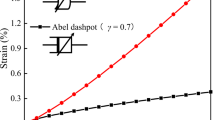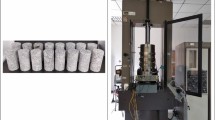Abstract
In this study, the time-dependent damage process of granite is investigated utilizing two numerical simulation schemes based on continuous method and discontinuous method. Numerical creep tests are carried out with both simulation schemes and mechanical responses and fracture patterns of rock specimens are analyzed. The calibrated numerical models can successfully reflect the typical creep stages observed in the laboratory. The predicted lifetime is in accordance with the laboratory test data. Comparisons are made between the two simulation schemes. It is found that both schemes have unique features that can promote a genuine reflection of the time-dependent damage process of the brittle rocks.
















Similar content being viewed by others
References
Anderson OL, Grew PC (1977) Stress corrosion theory of crack propagation with applications to geophysics. Rev Geophys 15(1):69–84
Atkinson BK (1984) Subcritical crack growth in geological materials. J Geophys Res Solid Earth 89(B6):4077–4114
Bobet A, Einstein HH (1998) Fracture coalescence in rock-type materials under uniaxial and biaxial compression. In J Rock Mech Mining Sci 35(7):863–888
Charles RJ (1958a) Static fatigue of glass. I J Appl Phys 29(11):1549–1553
Charles RJ (1958b) Static fatigue of glass. IT J Appl Phys 29(11):1554–1560
Chen W, Konietzky H (2014) Simulation of heterogeneity, creep, damage and lifetime for loaded brittle rocks. Tectonophysics 633:164–175
Chen S, Yue ZQ, Tham LG (2004) Digital image-based numerical modeling method for prediction of inhomogeneous rock failure. Int J Rock Mech Mining Sci 41(6):939–957
Chen W, Konietzky H, Abbas SM (2015) Numerical simulation of time-independent and -dependent fracturing in sandstone. Eng Geol 193:118–131
Eberhardt E, Stimpson B, Stead D (1999) Effects of grain size on the initiation and propagation thresholds of stress-induced brittle fractures. Rock Mech Rock Eng 32(2):81–99
Freiman SW (1984) Effects of chemical environments on slow crack growth in glasses and ceramics. J Geophys Res Solid Earth 89(B6):4072–4076
Hadley K (1976) Comparison of calculated and observed crack densities and seismic velocities in westerly granite. J Geophys Res 81(20):3484–3494
Homand-Etienne F, Hoxha D, Shao JF (1998) A continuum damage constitutive law for brittle rocks. Comput Geotech 22(2):135–151
Itasca (2005) FLAC fast lagrangian analysis of continua—theory and background. Itasca Consulting Group, Inc., Minneapolis
Itasca (2011) UDEC universal distinct element code—theory and background. Itasca Consulting Group, Inc., Minneapolis
Jay D (1995) Elasticity of minerals, glasses, and melts. Miner Phys Crystallogr Handbook Phys Constants 2: 45–63
Kemeny JM (1993) The micromechanics of deformation and failure in rocks, Int. symposium on assessment and prevention of failure of phenomena in rock engineering, Istanbul, Turkey, pp 23–33
Kemeny J (2005) Time-dependent drift degradation due to the progressive failure of rock bridges along discontinuities. Int J Rock Mech Mining Sci 42(1):35–46
Konietzky H, Heftenberger A, Feige M (2009) Life-time prediction for rocks under static compressive and tensile loads: a new simulation approach. Acta Geotech 4(1):73–78
Kranz RL (1983) Microcracks in rocks: a review. Tectonophysics 100(1):449–480
Lajtai EZ, Bielus LP (1986) Stress corrosion cracking of Lac du Bonnet granite in tension and compression. Rock Mech Rock Eng 19(2):71–87
Lee JS (2007) Time-dependent crack growth in brittle rocks and field applications to geologic hazards. Dissertations and Theses—Gradworks
Li X, Konietzky H (2015) Numerical simulation schemes for time-dependent crack growth in hard brittle rock. Acta Geotech 10(4):513–531
Lu Y, Elsworth D, Wang L (2014) A dual-scale approach to model time-dependent deformation, creep and fracturing of brittle rocks. Comput Geotech 60:61–76
Park N (2006) Discrete element modeling of rock fracture behavior: fracture toughness and time-dependent fracture growth. Dissertations and Theses—Gradworks
Potyondy DO (2007) Simulating stress corrosion with a bonded-particle model for rock. Int J Rock Mech Min 44(5):677–691
Potyondy DO, Cundall PA (2004) A bonded-particle model for rock. Int J Rock Mech Min Sci 41:1329–1364
Rinne M (2008) Fracture mechanics and subcritical crack growth approach to model time-dependent failure in brittle rock. Tkk Dissertations
Schmidtke RH, Lajtai EZ (1985) The long-term strength of Lac du Bonnet Granite. Int J Rock Mech Mining Sci Geomech Abstr 22(6):461–465
Souley M, Homand F, Pepa S, Hoxha D (2001) Damage-induced permeability changes in granite: a case example at the URL in Canada. Int J Rock Mech Mining Sci 38:297–310
Tada H, Paris PC, Irwin GR (2000) The stress analysis of cracks handbook. ASME Press, New York. https://doi.org/10.1115/1.801535
Wang Y, Tonon F (2009) Modeling Lac du Bonnet granite using a discrete element model. Int J Rock Mech Mining Sci 46:1124–1135
Weibull W (1950) A statistical distribution function of wide applicability. J Appl Mech 18(2):293–297
Wong TF (1985) Geometric probability approach to the characterization and analysis of microcracking in rocks. Mech Mater 4(3):261–276
Wu C, Mantell SC, Davidson JH (2010) Mixed-mode subcritical crack growth in orthotropic polymers. Polym Eng Sci 48(11):2216–2223
Xu T et al (2013) The evolution of rock failure with discontinuities due to shear creep. Acta Geotech 8:567–581
Xu T et al (2018) The modeling of time-dependent deformation and fracturing of brittle rocks under varying confining and pore pressures. Rock Mech Rock Eng. https://doi.org/10.1007/s00603-018-1491-4
Yu Q et al (2012) Meso-structure characterization based on coupled thermal-mechanical model for rock failure process and applications. Chin J Rock Mech Eng 31(1):42–51 (In Chinese)
Acknowledgements
This work was supported by the National Natural Science Foundation of China (NSFC, Grant No. 11402311 and No. 51608537). The authors thank the anonymous reviewers and editors for their valuable hints and suggestions for the improvement of this paper.
Author information
Authors and Affiliations
Corresponding author
Rights and permissions
About this article
Cite this article
Chen, W., Li, X. & Konietzky, H. Numerical simulation of lifetime and time-dependent damage for granite by continuous and discontinuous approaches. Environ Earth Sci 77, 594 (2018). https://doi.org/10.1007/s12665-018-7781-z
Received:
Accepted:
Published:
DOI: https://doi.org/10.1007/s12665-018-7781-z




